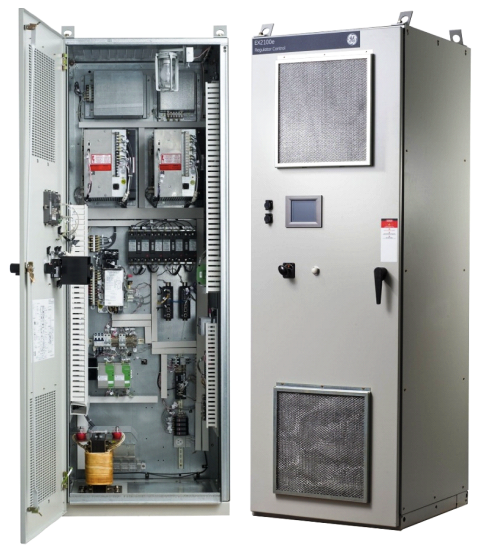
World of Controls has continually supplied GE Excitation control system cards and excitation modernizations for heavy-duty and aero-derivative gas, industrial and large steam, and hydro-powered generators. Many legacy generator control systems are limited by the technology of their era and require upgrades for operability and availability. ...
We are here to assist you with fully engineered and installed system replacements and "controls only" retrofits. Control hardware and software design is closely coordinated between GE's system and controls engineering to ensure the delivery of a true system solution. Integration is seamless between Excitation Control systems, Turbine Control systems, Static Starter Control systems, Integrated Control Systems (ICS), and the Human-machine Interface (HMI). For stand-alone retrofit applications, integration with customer-distributed control systems (DCS) through serial or Modbus Ethernet is supported. This document specifically addresses applications for the 35 A and 120 A (nominal) series of EX2100e Control Regulator systems.
The EX2100e Regulator system is available in several configurations to provide control flexibility for Thyristor and Regulator systems. For small Regulator systems, two pulse-width modulated (PWM) power converter modules use Insulated Gate Bipolar Transistors (IGBT) to provide up to 35 A or 120 A nominal output. These systems can support the following applications:
In the SCT/PPT regulator and DC rotating exciter regulator applications, the EX2100e Regulator system can de-sensitize the effect of the exciter time constant. It incorporates direct measurement of the generator field voltage and field current to enhance the speed of response to system transients.
The architecture is a single control with a single Power Control Module (PCM) or dual control with dual PCM, including a customer interface sub-system, optional diagnostic local operator interface (touchscreen), optional control operator interface (COI) remote touchscreen interface, control power input module, and PCM. The PCM consists of a bridge interface sub-system, a power bridge, optional AC and DC filter networks, and alternating current (AC) and/or DC isolation devices. For expanded input and output (I/O) capability, either VersaMax or Mark VIe control IONet I/O modules may be added.
The EX2100e Regulator system supports Ethernet local area network (LAN) communication to the following:
The EX2100e Excitation control products offer a Regulator control system in an 800 mm (32 in) enclosure with supporting hardware based on the particular application. Other packaging options are available. The Regulator system can be purchased as part of a finished cabinet, or individual components can be shipped separately for onsite mounting to better serve retrofit applications.
The EX2100e Regulator system is available in a warm backup (WBU) configuration, which includes dual exciter control I/O and protection. The control includes M1 (Master One) and M2 (Master Two), with two IGBT bridges that can accept separate or shared AC input power. The control configuration can also share a common DC output circuit with the exciter field through the transfer module. M1 and M2 are independent controls, each with automatic and manual regulator functions. Either M1 or M2 can control bridge firing, as determined by the operator. In the WBU configuration, M1 controls bridge #1, and M2 controls bridge #2.
The Power Conversion Module (PCM) consists of an integrated IGBT inverter module that contains six IGBTs connected in a 3-phase inverter configuration. Two of the six IGBTs are used to create the PWM DC output for field excitation. A third IGBT is used to discharge the DC link capacitors into an external DD resistor to prevent overvoltage.
The EX2100e control software supports high performance and helps the customer and field engineers understand, install, commission, tune, and maintain the excitation control system. The exciter software is configured and loaded from the ToolboxST application and resides in the controllers. The software is represented on the ToolboxST Component Editor screen by control blocks that are linked together to display the signal flow. The generator voltages and currents from the PTs and CTs are the source of the control signals needed by the automatic (generator terminal voltage) regulator, most limiters, and protection functions. They are wired to the ESYS, which acts as a signal conditioner to isolate and scale the signals. The conditioned signals are fed to the controller. The system simultaneously samples the AC waveform at high speed and uses advanced mathematical algorithms to digitally generate the needed variables. The output of the software transducer system includes the following:
Don't compromise on the reliability and performance of your industrial equipment. Contact us today to fulfill your legacy and renewal part needs for General Electric products. Reach out to us at [email protected], and our dedicated team will assist you in finding the right solutions for your specific requirements. Trust WOC for quality, efficiency, and prompt service.
WOC prioritize the reliability and performance of your excitation control systems. Our dedicated team of experts specializes in excitation system repair, ensuring that your power generation equipment operates seamlessly. Whether it's diagnosing issues with control system cards, addressing maintenance needs, or providing timely solutions, we're here for you. Choose us for GE Excitation system repair and let us help you maintain the heart of your power generation operations.